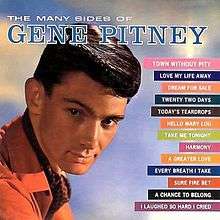The Many Sides of Gene Pitney
The Many Sides of Gene Pitney is the debut album of Gene Pitney, released on the Musicor label in 1962. It was mostly a collection of previously released singles. Among them was "(I Wanna) Love My Life Away" which charted at #39 on the Billboard Hot 100 on March 4, 1961 and was on the charts for eight weeks.[2] The song "Every Breath I Take" charted as high as #42 on September 16, 1961, and was on the charts for eight weeks.[3] "Town Without Pity" rose as high as #13 on January 27, 1962 and was on the charts for 19 weeks. [4] It also features two songs that Pitney had previously written for Ricky Nelson, "Hello Mary Lou" and "Today's Teardrops"; the latter also recorded by Roy Orbison.[1]
| The Many Sides of Gene Pitney | ||||
|---|---|---|---|---|
 | ||||
| Studio album by Gene Pitney | ||||
| Released | 1962 | |||
| Genre | Pop | |||
| Length | 29:36 | |||
| Label | Musicor | |||
| Producer | Aaron Schroeder | |||
| Gene Pitney chronology | ||||
| ||||
| Review scores | |
|---|---|
| Source | Rating |
| allmusic.com | |
Track listing
- "Town Without Pity" (Dimitri Tiomkin, Ned Washington) – 2:55
- "(I Wanna) Love My Life Away" (Pitney) – 1:56
- "I Laughed So Hard I Cried" (Aaron Schroeder, Ann Orlowski) – 2:19
- "Dream For Sale" (Phil Spector, Terry Phillips) – 2:34
- "Twenty Two Days" (Pitney) – 2:32
- "Today's Teardrops" (Schroeder, Pitney) – 1:56
- "Hello Mary Lou" (Pitney) – 1:56
- "Take Me Tonight" (Schroeder, Roy Alfred, Wally Gold) – 2:37
- "Harmony" (Pitney) – 1:58
- "A Greater Love" (Schroeder, Pitney) – 2:05
- "Every Breath I Take" (Gerry Goffin, Carole King) – 2:47
- "Sure Fire Bet" (Pitney) – 1:48
- "Chance to Belong" (Pitney) – 2:03
gollark: Regulators will probably not be able to separate them out.
gollark: They own WhatsApp and Instagram and whatnot.
gollark: I doubt it.
gollark: Uber will probably be bankrupt or failing because of regulatory issues and the fact that it does not actually make any money.
gollark: Oh yes, in a decade there'll probably be calls to get rid of analog radio broadcasts and digital broadcast TV, but they will likely stick around for quite a while.
References
- Richie Unterberger. "The Many Sides of Gene Pitney". allmusic.com.
- "Billboard Hot 100 - 4 March 1961, "(I Wanna) Love My Life Away"". Retrieved April 5, 2017.
- "Billboard Hot 100 - 16 September 1961,"Every Breath I Take". Retrieved April 5, 2017.
- "Billboard Hot 100 - 27 January 1962,"Town Without Pity"". Retrieved April 5, 2017.
This article is issued from Wikipedia. The text is licensed under Creative Commons - Attribution - Sharealike. Additional terms may apply for the media files.